Getting a TABC license can boost your chances of landing a bartender job in a restaurant serving alcohol. However, maximizing your profits requires more than just sales and service skills. TABC certification also protects your business from legal repercussions when serving alcohol to minors or intoxicated persons. Here are four reasons you should get TABC certified.
Reduced Business Liability
A TABC license and proper training can help protect your business from legal issues. Texas is a dram shop liability state, meaning that an establishment can be held responsible if it sells or serves alcohol to an intoxicated person who then causes injury or property damage. With TABC certification, you can learn how to check identification and understand the harmful impacts of alcohol properly. TABC courses also teach you how to promote responsible beverage service so that you can help keep your establishment safe for customers and employees alike. A TABC license can also help you reduce your liabilities as a seller or server by showing that you’re committed to following state alcohol laws and keeping minors out of your bar or restaurant. You can even use your TABC permit to sell alcoholic beverages to-go in areas that were previously off-limits. This is especially helpful for restaurants and other businesses that sell food with their drinks.
Legal Compliance
TABC certification ensures that your employees understand liquor laws and helps them spot intoxicated customers and intervene when necessary. It also teaches them how to check IDs and serve alcohol to people of legal drinking age. It’s a class A misdemeanor to serve alcohol to minors, and the consequences of doing so can be costly for businesses. Moreover, the TABC’s Audit and Investigations Department conducts investigations, financial reviews, inspections, and more to promote responsible sales and service. They even work on presentations at schools to raise awareness on the issue of underage drinking. They also monitor seller training and help process excise tax reports. Aside from meeting state rules, localities may have their requirements that you need to meet before you get your TABC license or permit. These include local ordinances, zoning restrictions, insurance requirements, fees, standards for late-hour business operations, and certificate of occupancy regulations.
Improved Job Prospects
TABC certification can improve your job prospects by making you more marketable as a candidate. Bartenders, waitstaff, and other hospitality workers with TABC training can easily stand out when applying for jobs at restaurants and other establishments that sell alcohol. In addition to improving your job prospects, TABC certification offers benefits like legal compliance, improved customer service, and reduced business liability. It helps you avoid legal repercussions for serving minors or intoxicated people. It teaches you to perform thorough ID checks and use band or stamp systems to ensure children aren’t served. TABC certification doesn’t require you to enroll in expensive college courses or spend countless hours with a teacher. You can find various options for getting certified online, including self-paced courses for busy people, hybrid classes that combine online and in-person instruction, and even school packages. Many of these programs cost less than a meal out.
Increased Revenue
TABC licensing is mandatory for anyone who works at a bar, restaurant, or other establishment that sells alcoholic beverages. This ensures that servers know how to serve alcohol, helping keep customers safe and happy. Additionally, it teaches them how to spot when someone has had too much to drink so that they can be cut off before they cause an accident. As a result, TABC says that those with a TABC license can better serve their patrons and are more likely to make a positive impression on customers. This helps their business grow and thrive. A TABC license also allows you to take advantage of various secondary permits, such as the food and beverage certificate or late-hours permit. These additional licenses can increase your revenue and help you meet the needs of your patrons.


